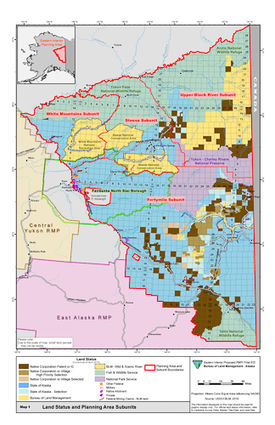BLM seeks balance
Interior Alaska plan opens acreage to mining, creates conservation areas
Last updated 2/6/2018 at 7:45pm
Roughly 74 percent of U.S. Bureau of Land Management-administered lands in Alaska's Eastern Interior region will be off limits to mining, according to the preferred resource management plan published July 30 by the federal land manager.
BLM is responsible for the management of 6.5 million acres in the federal government's Eastern Interior planning area, a roughly 30-million-acre, triangle-shaped expanse of eastern Alaska that stretches from the Yukon Territory border to a point about 240 miles into the interior of the state. This area, roughly the size of New York State, blankets most of five historic mining districts – Fortymile, Goodpaster, Fairbanks, Circle and Tolovana (Livengood). It has produced more roughly 21 million ounces of gold and is known to host a broad range of other minerals.
BLM said its preferred plan, which is set to serve as a framework for decision-making across this swath of Alaska going forward, seeks to strike a balance between responsible development and conservation.
"We've worked hard to listen to the concerns of a diverse group of local stakeholders who rely on these public lands for their subsistence, mineral development, and recreation," said BLM Alaska State Director Bud Cribley. "The result is a plan that balances resource use and development in a way that conserves important natural and cultural values."
Mixed bag in Fortymile
BLM attempted to reach a balance between mining and conservation in the Fortymile subunit, a 15-million-acre region that covers the southern half of the Eastern Interior planning area, including much of the Fortymile, Goodpaster and Fairbanks mining districts.
The preferred alternative of the Eastern Interior management plan proposes opening up roughly 1.13 million acres, or about 60 percent of the some 1.89 million acres of BLM-administered lands in the Fortymile subunit to mineral exploration and mining. The plan, however, also proposes tying up 745,000 acres in conservation units that would be off limits to development. The move also includes expanding wild and scenic designations along the Fortymile River and placing about 399,000 acres in controversial conservation units known as Areas of Critical Environmental Concern.
The largest ACEC designation in the Fortymile District measures roughly 80 miles by 10 miles in a corridor of federal lands that border the southeast side of the Yukon-Charley Rivers National Preserve. The designation also traps blocks of state and Alaska Native lands in an island between a national reserve and the environmental conservation area.
Many believe that BLM's use of ACEC to set aside large tracts of Alaska for conservation breaks a promise the federal government made to Alaska in 1980, when it placed 106 million acres of federal lands in the 49th State into conservation units as part of the Alaska National Interest Lands Conservation Act.
"This new designation violates ANILCA and would negatively impact Alaskans, who have already faced repeated resource-related restrictions from the federal government in recent years," Sen. Lisa Murkowski, R-Alaska, responded to BLM's initial ACEC proposal in 2015.
In brief, ANILCA promises that the federal government will not withdraw more than 5,000 acres of Alaska public lands without an act of Congress.
The Alaska Miners Association considers the use of ACECs as a way to skirt this promise and further debilitate resource opportunities on BLM lands in Alaska.
"The Fortymile ACEC, and the proposal of others in the western and northern regions of the state, closes off opportunities for mining on federal lands to expand in the future," AMA inked in a 2015 letter to U.S. Department of Interior Secretary Sally Jewell.
Steese, White Mountain remains locked
Virtually all of the BLM-administered lands in the Steese and White Mountain subunits of Eastern Interior, which cover much of the historic Circle and Tolovana mining districts, are off limits to mining under the preferred management plan.
Only about 34,000 acres of the roughly 2.3 million acres of BLM lands in these mineral-rich areas north of Fairbanks would be open to mining under BLM's preferred alternative. The areas where mining would be allowed under the plan consist largely of existing federal mining claims.
There had been some hope that promising mineral areas currently encompassed by the Steese National Conservation and White Mountains National Recreation areas would be opened up for mining. These areas, which were established under ANILCA, make up nearly all of the BLM lands in the two namesake subunits in which they reside.
A 160,000-acre region of the White Mountain Recreation Area prospective for rare earth elements and gold is of particular interest.
A geological study carried out by a team of Alaska and federal agencies in 1987 came to the conclusion that a portion of the recreation area hosts an estimated 1.5 million ounces gold, 10 million oz. silver, 520 tons of REE, 520 tons of uranium and 320,000 tons of tin. This estimate was based on limited exploration and there is the belief that these deposits could be substantially larger.
The actual potential of this area could be better understood could be further realized if made available by BLM, a move that also might have helped quell some of the qualms over locking up portions of the Fortymile district in ACECs.
One of the alternatives of the Interior Alaska management plan proposed opening some 842,000 acres of the more prospective mineral areas in these conservation areas – 160,000 acres in White Mountain and 682,000 acres in Steese – to mineral exploration and potential mining. In the preferred alternative, however, BLM proposes leaving these mineral prospects locked up in conservation units.
The federal manager's proposal for the Eastern Interior RMP remains open for public comment until Aug. 27, and BLM anticipates a final decision on the proposed plan in December.


















Reader Comments(0)